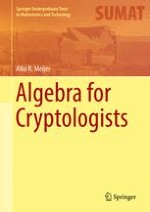2016 | OriginalPaper | Buchkapitel
9. Applications to Block Ciphers
verfasst von : Alko R. Meijer
Erschienen in: Algebra for Cryptologists
Aktivieren Sie unsere intelligente Suche, um passende Fachinhalte oder Patente zu finden.
Wählen Sie Textabschnitte aus um mit Künstlicher Intelligenz passenden Patente zu finden. powered by
Markieren Sie Textabschnitte, um KI-gestützt weitere passende Inhalte zu finden. powered by
